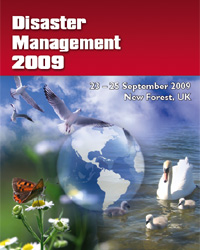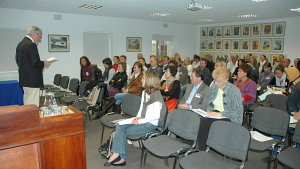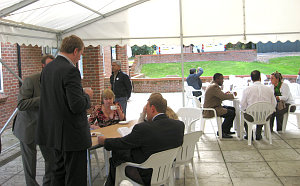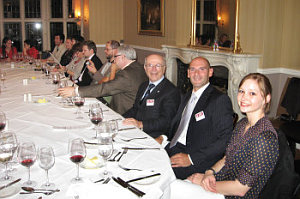![]() 23 -25 September 2009
23 -25 September 2009
New Forest, UK
Overview

The 1st International Conference on Disaster Management and Human Health Risk has recently taken place at the Wessex Institute of Technology (WIT) Campus in the New Forest, England. The co-chairs of the meeting and co-editors of the book were Professor Kirsty Duncan from the University of Toronto (also a Canadian MP) and Professor Carlos Brebbia, director of WIT.
Carlos opened the conference stating the importance of the topic.
Recently, there has been a disturbing increase in the number of natural disasters affecting millions of people, destroying property and resulting in loss of human life. These events include major flooding, hurricanes, earthquakes and many others.
Today the world faces unparalleled threats from human made disasters that can be attributed to failure of industrial and energy installations as well as terrorism. Added to this is the unparalleled threat of emerging and re-emerging diseases, with scientists predicting events such as an influenza pandemic.
 All these events pose unprecedented risks to human health on a world scale which requires a massive effort by the international community. This conference therefore focuses on current global health risks, and how best to prepare for, respond to and recover from disasters in order to reduce human health impacts.
All these events pose unprecedented risks to human health on a world scale which requires a massive effort by the international community. This conference therefore focuses on current global health risks, and how best to prepare for, respond to and recover from disasters in order to reduce human health impacts.
The conference aimed to help participants to understand the nature of global risks, learn risk management strategies to prepare for disruptive events, and identify the best prevention methods in disaster management and public health. It also provided a forum for the exchange of information between leading academics and partners in disaster management.
Presentation by Kirsty Duncan
Carlos then introduced his co-chair Kirsty Duncan who could not attend the conference due to her parliamentary duties and sent instead an inspiring digital presentation.
Kirsty Duncan is a member of the Canadian Parliament for Etobicoke North and a Associate Professor (on leave) for the Health Studies Centre of the University of Toronto, of which she was research director.
She is a well known international speaker, who has lectured for organisations such as National Geographic (USA), the Japanese government and that of Portugal.
Kirsty led a famous expedition to discover the casual agent of the 1918 Influenza and this resulted in a book which received excellent reviews all over the world.
Her background is in Geography and Anthropology with a first degree from the University of Toronto and a PhD in Geography from the University of Edinburgh. She has worked at different university and schools.
Dr Duncan’s second acclaimed book is entitled “Environment and Health – Protecting Our Common Future” was published by WIT Press in 2008 and became a bestseller.
She has completed work regarding climate change and human health for the Intergovernmental Panel on Climate Change (IPCC), the renown joint venture of the United Nations Environmental Programme and the World Meteorological Organisation, and contributed in this way to the Nobel prize wining Canadian team of the IPCC.
Kirsty addressed the conference on the various challenges facing the world today. She said.
“Today, the world faces unprecedented disasters. For example, in 2005, an ‘unparalleled frequency and scale of natural disaster’ tested the international relief community; Hurricane Katrina, alone destroyed 300,000 homes, displaced 770,00 people, and cost US$200 billion.”
“In 2009, the Centre for Research on Epidemiology of Disasters found that natural disasters killed 235,000 people, affected 214,000,000 people and cost US$190 billion in 2008. The death toll was three times higher than the annual average for the years 200-2007 because Cyclone Nargis killed 138,366 people in Myanmar, and the Sichuan earthquake killed 87,476 people.”
“Although these statistics are difficult to conceptualise, each increment matters because it means one household lost a family member, lost a home, or lost an investment. The numbers are not abstract, but rather, represent terrible change in the lives of real people.”
“This conference is of paramount importance because it focuses on current global risks, and how best to prepare for, respond to, and recover from disasters in order to reduce human health impacts.”
“Just a few short weeks ago, numerous countries around the world responded to: (1) natural disasters, including Benin, China and Vietnam to flooding; and (2) technological disasters, including Italy and Peru to a train accident and bus collision, respectively.”
“Today, the world, however, is responding to the first influenza pandemic in over 40 years, and perhaps bracing for a second wave of the novel influenza A (H1N1) virus in the autumn. For the first time, we have two new viruses coexisting – namely influenza A (H1N1) at the World health Organisation (WHO)’s pandemic alert level 6, and influenza A (H5N1) at alert level 3.”
“Expecting the unexpected is essential, and keeping the public appropriately engaged will be a considerable challenge. Countries, communities and organisations must recognise that choosing the least cost, effort and time is a choice – and they must decide how to protect employed and the community. ‘Afterwards, history will judge today’s leaders on how well they took decision on the ethical challenges they faced in the midst of the crisis.’”
She then referred to the challenge presented by climate change as follows.
“While pandemic influenza remains the most pressing human healt threat, climate change remains our most daunting environmental threat – as considerable time lags in the climate system mean that many aspects are already locked in over the coming decades.”
“Global climate change will, for example, increase sea level by 0.09 to 0.88m. Currently some 46 million people experience flooding due to storm surges (an abnormal rise in sea level along a shore primarily due to the winds of a storm). A half-metre sea-level rise would increase the number of vulnerable to 92 million; a one-metre sea-level rise would increase the number of vulnerable to 118 million.”
“What must be done globally, nationally, regionally, corporately and personally to slow emissions of greenhouse gases? What must countries do to adapt to rising sea levels – for example, in Vanuatu, where in 2005, an entire coastal village in the northern region had to be relocated to higher ground.”
“What are the potential health impact of extreme weather in Vanuatu or other smallisland states? Are they physical injury, impacts on mental health, increased risk of water related diseases as a result of disruption of water supply or sewage systems, release and dissemination of dangerous chemicals from storage sites and water disposal sites into flood waters? And what should be done to prepare for each identified impact?”
“Globally, climate change will certainly impact the frequency and intensity of extreme weather events, such as droughts and floods. And population growth, poverty, and urbanisation will likely increase the number of people who are vulnerable to these natural hazards.”
“Failure to limit change to 2°C above pre-industrial levels will make it impossible to avoid potentially irreversible changes to Earth’s ability to sustain human development. We have a five in six chance of maintaining the 2°C limit, if worldwide greenhouse gas emissions are reduced by 80% by 2050 relative to 1990.”
Kirsty concluded with the following remarks.
“As we debate the important work examining the links between disasters and human health, keep in mind our most overwhelming challenges, namely, pandemic influenza, climate change, and the global economic crisis – which will have, no doubt, impacted funding for preparedness and response for disasters."
Keynote Addresses
There were three keynote addresses by well known colleagues during the meeting.
- “Seismic vulnerability of a slope in central Italy”
M Maugeri, University of Catania, Italy - “Earth observation and network of in situ ground sensors for disaster management and early warning”
V Ferrara, University of Rome ‘La Sapienza’, Italy - “Training decision-makers in hazard spatial prediction and risk assessment: ideas, tools, strategies and challenges”
A G Fabbri, SPINlab, The Netherlands
Conference Topics
The papers were classified into the following topics.
- Risk prevention monitoring
- Analysis, monitoring and mitigation of natural and man-made disasters
- Emergency preparedness and risk mitigation
- Natural disasters
- Learning from disasters
Social Activities
 The delegates had a busy social programme as well which contributed to creating new contacts and links between different research groups.
The delegates had a busy social programme as well which contributed to creating new contacts and links between different research groups.
The conference began with a barbeque in the grounds of the Institute, and the pool and relaxation areas. The excellent food helped contribute to the friendliness of the occasion, in which delegates and some research staff of the Institute participated as well as the delegates of an associated meeting on Environmental Health Risk.
During the second day delegates visited Bucklers Hard in the New Forest. This is a very picturesque site of historical interest. Ships were built there for nearly 100 years with oaks from the New Forest. At its height there were five slipways and around 20 cottages in the village. Only two rows of cottages now remain with a broad village street separating them and sloping towards the river. At the end of one of these now stands a hotel, which was the mater builder’s house, and one of the builder’s cottages is now a tiny chapel. An excellent display at the entrance of the village describes the activities that took place.
Many wooden ships were built there including the famous Agamemnon, commanded by Nelson during the siege of Calvi, where he lost the vision in his right eye, together with the Swiftsure and Euryalus, all built at Bucklers Hard, took part in the Battle of Trafalgar. The weather was excellent and the participants were able to enjoy the unique sights and scenery.
Conference Dinner
 The conference dinner took place in a large Manor House in the New Forest, called Rhinefield House, now an excellent hotel. This was one of the residences of one of the Master Keepers of the Forest, until at the end of the 19th century it was sold to a family who owned collieries in Nottingham. They then started to rebuild the house.
The conference dinner took place in a large Manor House in the New Forest, called Rhinefield House, now an excellent hotel. This was one of the residences of one of the Master Keepers of the Forest, until at the end of the 19th century it was sold to a family who owned collieries in Nottingham. They then started to rebuild the house.
The house has the aspect of a neo-gothic castle and consists of a series of large reception rooms and apartments. It was sold in the 1950’s and different enterprises were accommodated there without much success until the 1970’s when it was restored and started to function as a hotel.
The most impressive room in the house is the great hall with a hammer-beam roof resembling the one in Westminster Hall in London. In keeping with the variety of styles in the house, the dining room is beautifully paneled with a large carving on the mantelpiece representing the defeat of the Spanish Armada. Other smaller rooms are decorated in Italian and French styles, the most surprising is a small room decorated in a style resembling the Alhambra palace in Granada. The beautiful settings were fit for the excellent cuisine and good wines offered during the banquet.
The success of the conference will ensure that it is reconvened in 2011 in a location and date to be shortly decided.
Publication of Papers
 The proceedings of Disaster Management and Human Health Risk: Reducing Risk, Improving Outcomes, 416pp (Print ISBN: 1-84564-202-0; On-line ISBN: 1-84564-379-9; Print ISSN: 1746-4498) are available from WIT Press priced at £158/US$284/€205. Orders can be placed by telephone: +44 (0) 238 029 3223, fax: +44 (0) 238 029 2853, e-mail:
The proceedings of Disaster Management and Human Health Risk: Reducing Risk, Improving Outcomes, 416pp (Print ISBN: 1-84564-202-0; On-line ISBN: 1-84564-379-9; Print ISSN: 1746-4498) are available from WIT Press priced at £158/US$284/€205. Orders can be placed by telephone: +44 (0) 238 029 3223, fax: +44 (0) 238 029 2853, e-mail:
Papers from the conference will also be hosted online at the WIT eLibrary as Volume 110 of WIT Transactions on The Built Environment (On-line ISSN: 1743-3509.). For more details visit the WIT eLibrary at www.witpress.com
Patagonia a forgotten land – from Magellan to Peron, by C.A. Brebbia, 384 pp (ISBN 978-1-84564-061-3) is available in hard back from WIT Press, priced at £33/US$59/€49.50. Orders can be placed as above.
The New Forest: A Personal View, by C.A. Brebbia, 128pp (ISBN 1-84564-145-0) is available in hard back from WIT Press, priced at £19.50/US$39/€26. Orders can be placed as above.


 Wessex Institute
Wessex Institute